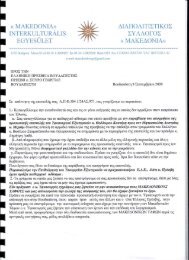Görög Örökség Ελληνική Κληρονομιά - H-ellin.com
Görög Örökség Ελληνική Κληρονομιά - H-ellin.com
Görög Örökség Ελληνική Κληρονομιά - H-ellin.com
You also want an ePaper? Increase the reach of your titles
YUMPU automatically turns print PDFs into web optimized ePapers that Google loves.
Marriann Olbert<br />
The three most notable churches and shrines of the<br />
Greek Diaspora In Hungary: Eger, Miskolc and<br />
Budapest.<br />
The Greek traders were given the chance to erect their Orthodox churches only after the Decree of<br />
Tolerance was issued in 1781 by Josef B'. However, although the Decree approved of the building<br />
of the churches for non-catholic believers, there were a lot of restrictions, such as there should not<br />
be any bell-towers or bells, and the buildings had to meet the requirements of the architecture that<br />
prevailed in the Empire.<br />
1. Eger: Serbian-Greek church "The transfer of the relics of Agios Nikolaos" ( Serbian<br />
Church)and its screen.<br />
In the 18' century, the Serbians and Greeks of Eger belonged to a <strong>com</strong>mon church <strong>com</strong>munity,<br />
where either the Serbian or the Greek element was expressed. Between 1729-32 the Serbians and<br />
Greeks reconstructed partly their old church and in 1753- after a hard bargain- built on top of it a<br />
baroque bell-tower. In 1785, after the permission of Emperor Josef B' (17-19 October 1784), which<br />
he gave after witnessing the awful state of the church, they built their new one. On 31 July 1786,<br />
they put the cross on the bell-tower and blessed the interior though it was not yet finished. The main<br />
motive of the screen in Eger is the grape (the bunch, the spirals and the leaves) which other than<br />
Thanksgiving, stresses the main business activity in the city, which was winery Due to the gradual<br />
adaption and after the vanishing or moving of the Greeks and Serbians, the Serbian Orthodox<br />
Church(Szentendre) is operating the church as a museum.<br />
2. Miskolc: The Hungarian Orthodox Church of the Holly Trinity and its screen.<br />
During the 1750s, the Greek <strong>com</strong>munity in Miskolc maintained a chapel named after Agios Naoum.<br />
Abraham Voy bought the land with the chapel and was renting it since 1745 to the Greeks. The<br />
beginning of the construction of a church in Miskolc is presumed to have been in 1782. Concerning<br />
the building of the church and the creation of the interior, the designs were drawn three times, in<br />
1776, in 1784 and in 1785. The inscription of the foundation stone, placed on the entrance of the<br />
church on the west side, is as follows: " This is the church of the Holly Trinity. The construction<br />
works started in 1785 during the reign of the emperor and king of Hungary, Josef B' and was<br />
<strong>com</strong>pleted in 1806 during the reign of the emperor and king of Hungary Francis B'. It was erected<br />
with the donations given by the Macedonian-vlachoi brothers.". Thw masterpiece of the church is<br />
considered to be the shrine of Miskolc with its 17 meters height. In 1944 the bell-tower was<br />
damaged because of a shooting and its restoration was <strong>com</strong>pleted in 195 5.<br />
3. The Hungarian Orthodox Church of Koimiseos Theotokou(the Dormition of the<br />
Virgin)<br />
In Budapest and its screen.<br />
The Greeks in Budapest originally exercised their religious belief in the existing church of the<br />
Serbians in Szerb street, since the 1Τ century. In 1783, they were given the chance to listen to the<br />
mass in the greek language, every second Sunday. In 1788 the Greeks and Macedonian-vlachoi of<br />
Pest decided to be<strong>com</strong>e separated by the Serbs and issued and official claim in the Governing<br />
Council in order to be allowed to build a church. The foundation stone was placed in 1791 and the<br />
building started. In 1800, Miklós jankovics <strong>com</strong>pleted the construction of the church. In the shrine of<br />
the church in Petőfi square appear images of western origin which are not indicative of the iconpaintings<br />
of the Greek sin Hungary. In 1809 the church was <strong>com</strong>pleted both outside and inside.. The<br />
wealthy Greek families did not consider that the bell-towers were inappropriate and they changed<br />
them in 1873 based of the design of Ybl Miklós. In 1931 the church <strong>com</strong>munity was named "By the<br />
Greeks Established Orthodox Hungarian Community".<br />
The reconstruction of the building after the Second world War lasted from 1946 until 1949 and then<br />
it stopped. The exterior was renovated in 1953 and since 1972 the whole renovation of the exterior<br />
of the building started. The south bell-tower was destroyed during bombings and the works for the<br />
reconstruction started in 2008.<br />
126




